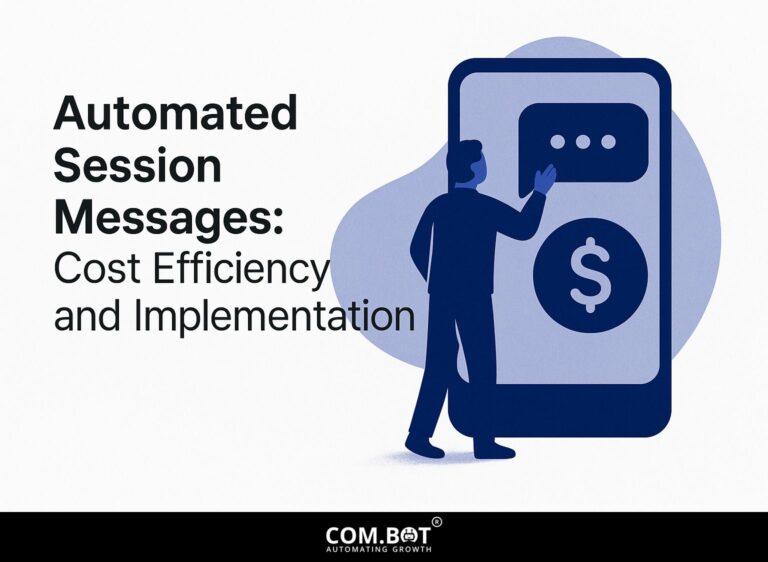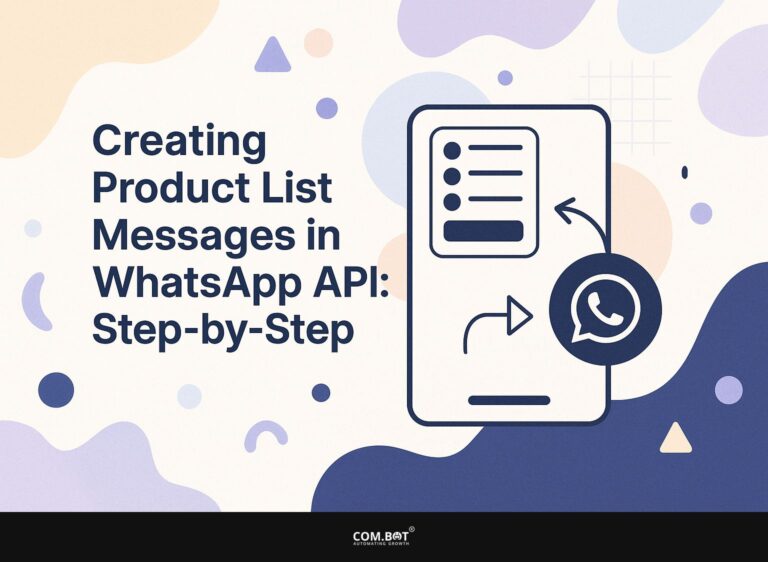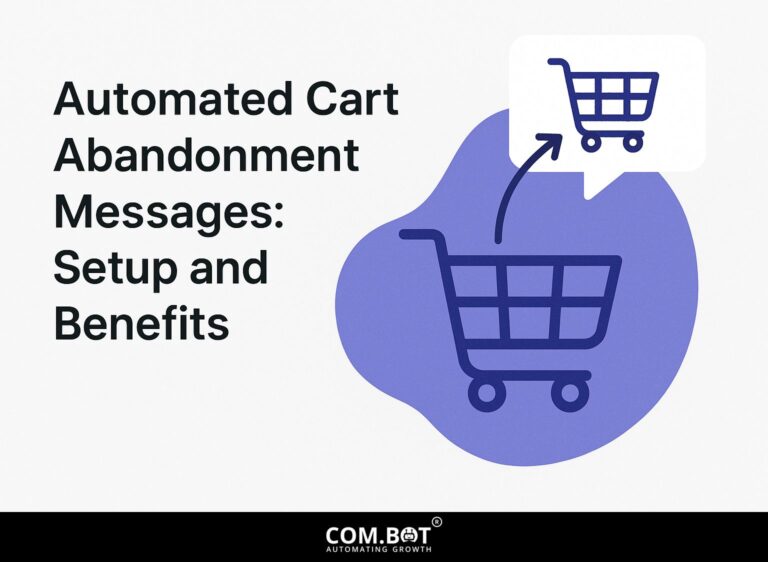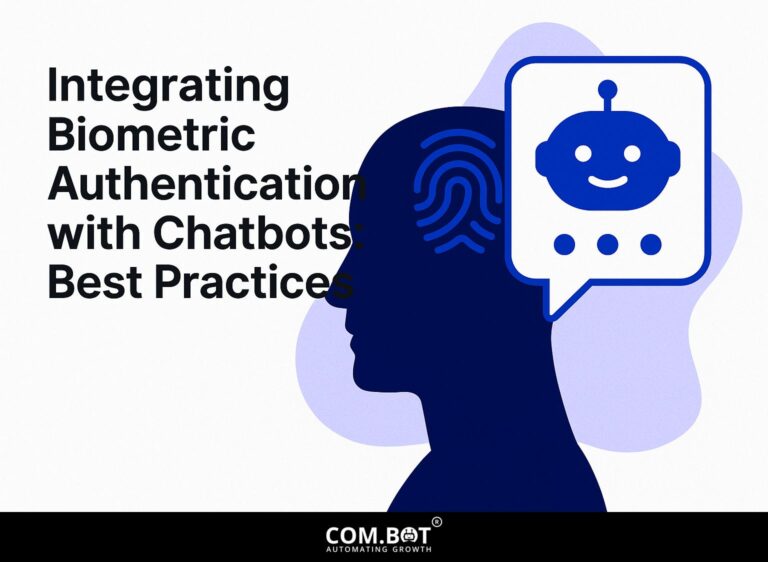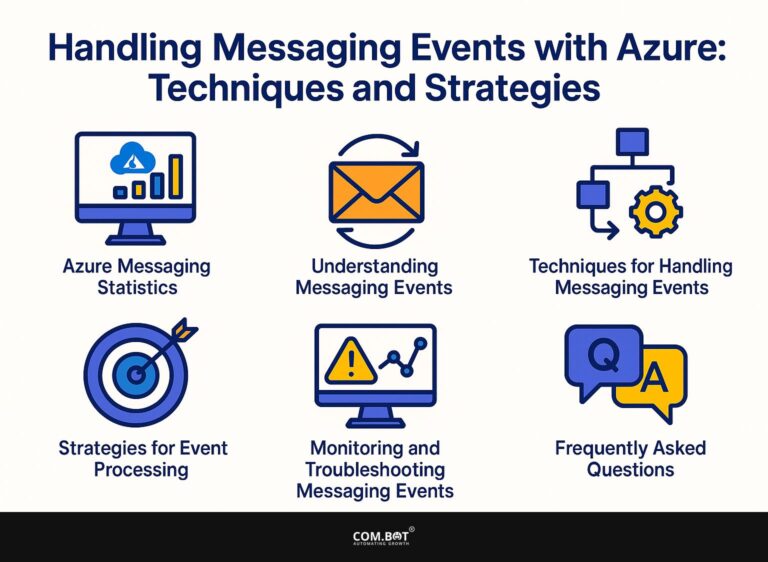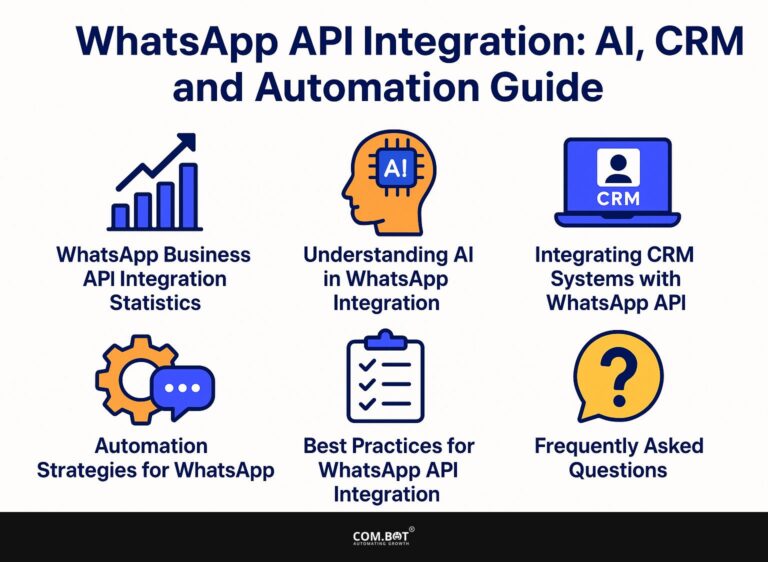Top 5 WhatsApp Chatbots 2025: Features and Applications
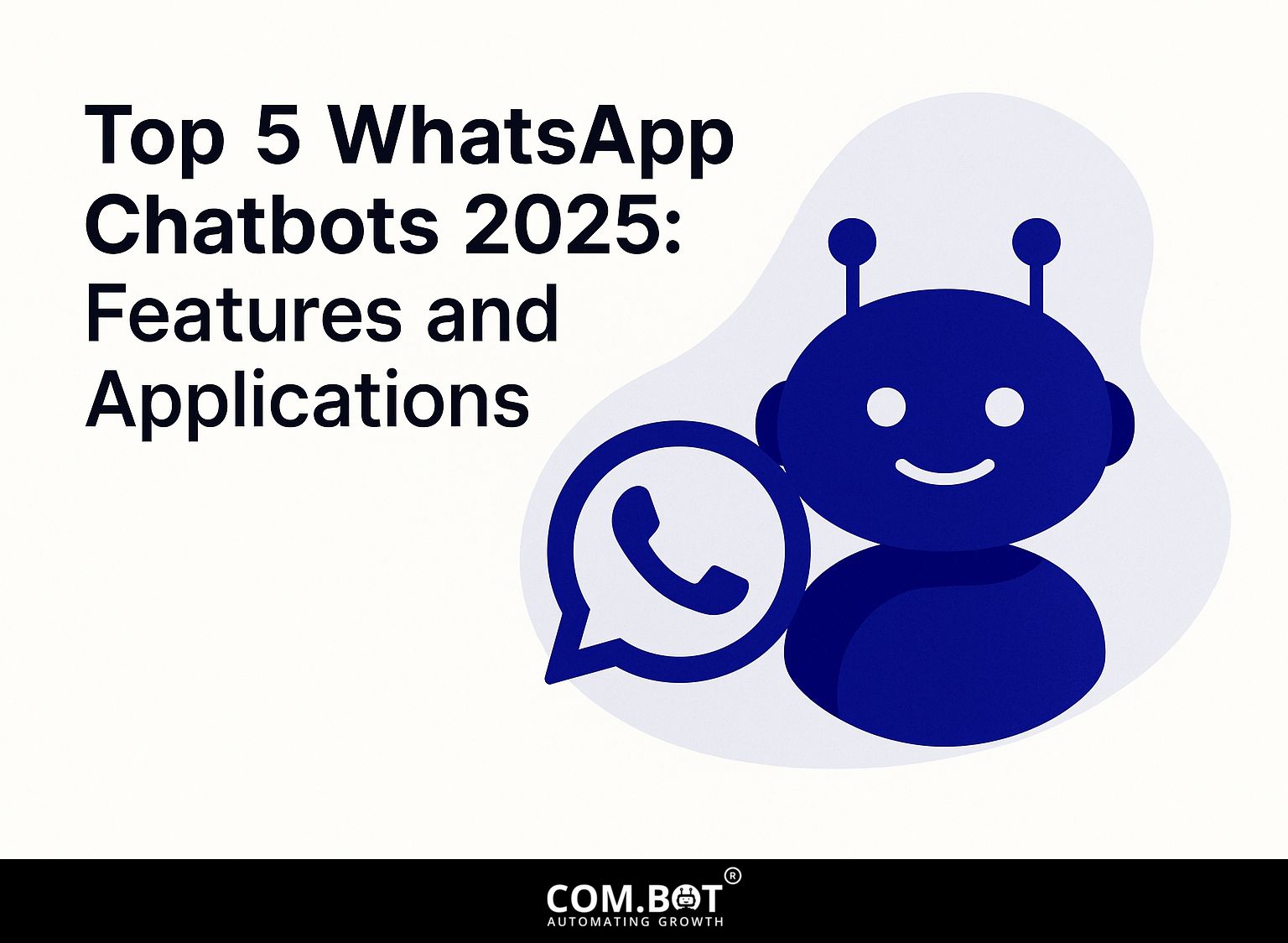
As WhatsApp remains a leading messaging platform, chatbots are changing customer support by handling tasks automatically. In 2025, innovative solutions like Manychat and Chatbase are leading the charge, enhancing user interactions and streamlining service processes. This article reviews the top 5 WhatsApp chatbots, pointing out their specific features and uses to help businesses work better and make customers happier. Learn how these tools can change your approach to interacting with customers now!
Key Takeaways:
- Chatbots on WhatsApp will keep expanding and be important for customer support, marketing, and healthcare in 2025.
- The top 5 chatbots on WhatsApp will have advanced functionality, seamless user experience, and integration capabilities.
- These chatbots will have diverse applications across industries, providing efficient solutions for customer support, marketing, and healthcare needs.
- 1 WhatsApp Chatbot Usage Statistics 2025
- 2 Criteria for Selection
- 3 Top 5 WhatsApp Chatbots of 2025
- 4 Applications Across Industries
- 5 Frequently Asked Questions
- 5.1 1. What are the top 5 WhatsApp chatbots expected in 2025?
- 5.2 2. What are the key features of these WhatsApp chatbots?
- 5.3 3. How can businesses use these chatbots to their advantage?
- 5.4 4. What are the potential applications of WhatsApp chatbots in 2025?
- 5.5 5. Will these chatbots replace human interaction on WhatsApp?
- 5.6 6. What should users and businesses keep in mind when using WhatsApp chatbots?
1. Definition and Importance
A WhatsApp chatbot is an AI-driven tool that automatically manages conversations, improving customer service and support on the well-known messaging app. These bots can manage questions, handle orders, and give custom replies all day and night.
For example, clothing retailer H&M uses a WhatsApp chatbot to help customers find outfits based on their preferences, improving engagement and sales. Similarly, KLM Royal Dutch Airlines employs a chatbot for booking confirmations and flight updates, significantly reducing customer wait times.
To set up this kind of system, businesses can use tools like Twilio or Landbot. These tools offer user-friendly interfaces for creating chatbots that fit their customers’ exact requirements. If you’re interested in learning more about the process, here is a step-by-step guide on creating a WhatsApp AI chatbot.
2. Growth of Chatbot Technology
The chatbot market is projected to reach $9.4 billion by 2024, showcasing an annual growth rate of over 24% driven by advancements in AI and automation. Businesses are using chatbots more often to improve customer service and interaction.
For instance, Sephora uses chatbots for product recommendations, resulting in a 20% increase in customer engagement. Pizza Hut launched a chatbot to take orders, making the process faster and reducing wait times.
With tools like Drift and Intercom, companies can quickly create chatbots to improve communication and make customers happier. As more organizations recognize the benefits, we can expect an even greater surge in their integration across various sectors. For an extensive analysis of this trend, our deep dive into AI WhatsApp Bots provides insights into their definition, benefits, and notable use cases, shedding light on their expanding role.
WhatsApp Chatbot Usage Statistics 2025
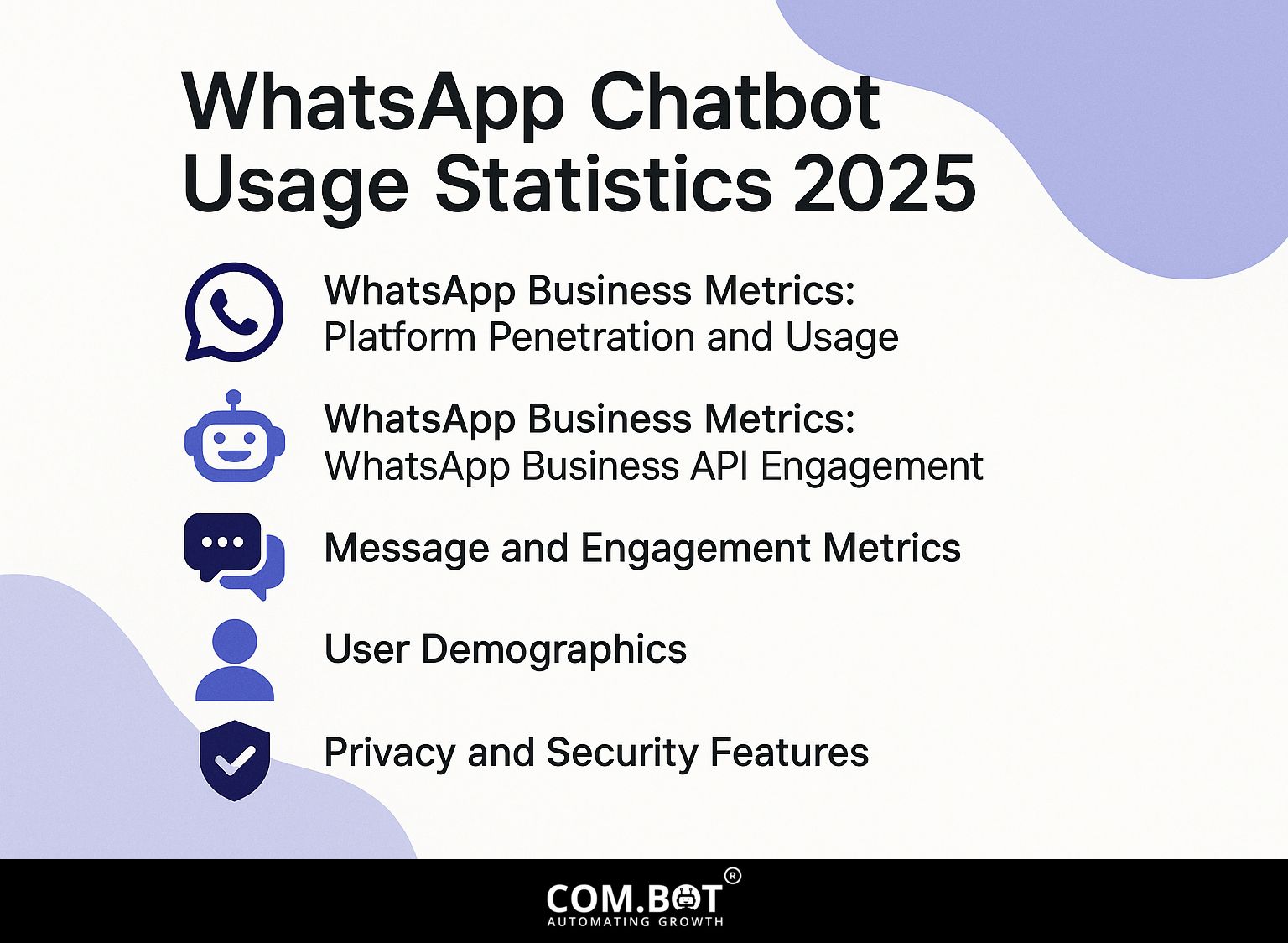
WhatsApp Business Metrics: Platform Penetration and Usage
WhatsApp Business Metrics: WhatsApp Business API Engagement
WhatsApp Business Metrics: Message and Engagement Metrics
WhatsApp Business Metrics: User Demographics
WhatsApp Business Metrics: Privacy and Security Features
The WhatsApp Chatbot Usage Statistics 2025 show the widespread use and varied application of the platform, highlighting its importance in personal and business communication worldwide. With 2.93 billion global users and 130 billion messages sent daily WhatsApp remains a leading messaging app globally, providing a strong channel for personal and business communication.
WhatsApp Business API Engagement reveals that 400 million businesses use WhatsApp’s API to interact with their customers, making it easier 2.2 billion messages exchanged daily between businesses and customers. This high level of engagement is reflected in impressive metrics such as a 91% customer satisfaction rate and a 31% increase in catalog views. Furthermore, 54% of users prefer WhatsApp for customer support, indicating a strong user inclination towards using the platform for timely, effective service interactions.
Message and Engagement Metrics highlight daily user engagement, with 1.7 billion daily active users and 19 billion pieces of media shared daily. In-app features like voice notes and emojis see significant usage, with 62% of users utilizing voice notes and 72% of messages using emojis, showing the platform’s ability to match users’ ways of expressing themselves.
User Demographics indicate a nearly balanced gender distribution with 53.9% male and 46.1% female users. Age-wise, the 26-35 age group represents the largest user base at 27%, while users aged 56+ account for 13%, demonstrating broad appeal across different age demographics.
Privacy and Security Features are vital to user trust, with 98% of messages end-to-end encrypted, ensuring secure communications. Additionally, features like disappearing messages and the chat lock are used by 46% and 65% of users respectively, highlighting the importance of privacy and control in user experience.
This data shows that WhatsApp is more than just a messaging app. It is an essential tool for personal, social, and business interactions, constantly updating to meet user demands and new technology, keeping its top spot worldwide.
Criteria for Selection
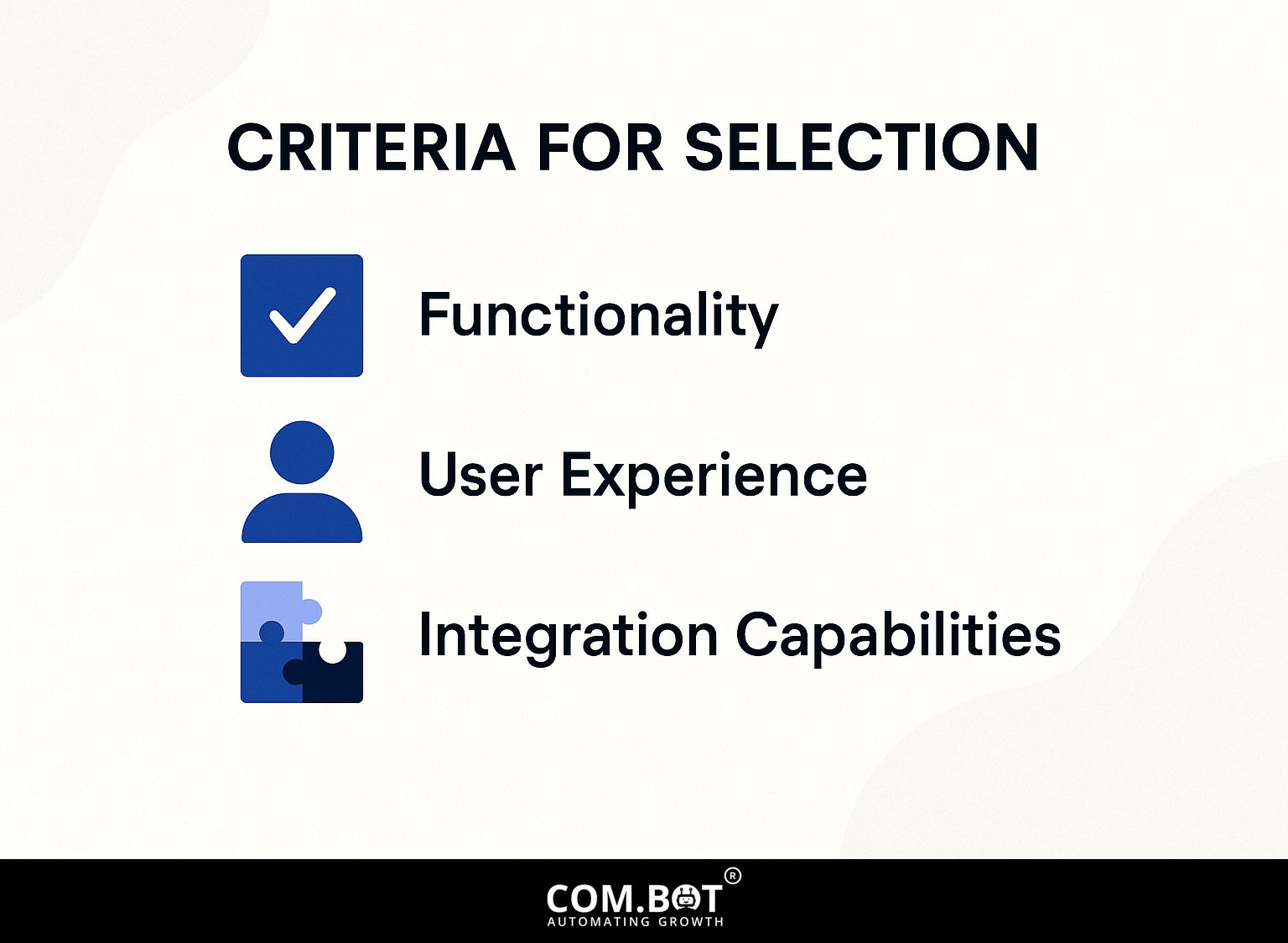
Picking the right WhatsApp chatbot requires examining important factors to make sure it fits your business needs.
1. Functionality
WhatsApp chatbots can send automatic replies, group users based on certain criteria, and offer settings to tailor user experiences.
By setting up automatic replies, companies can answer common questions right away, which makes responses faster and keeps customers happy.
Tools like Manychat make it simple to set up these automatic replies, helping businesses offer support at all hours. User segmentation improves engagement by sending messages based on customer behavior. Chatbase makes this easy by examining user interactions.
Customization options allow brands to convey their identity, ensuring that interactions feel personal and relevant. These strategies simplify communication and help build better customer relationships.
2.User Experience
A user-friendly interface and intuitive design are critical for ensuring high engagement rates with WhatsApp chatbots, leading to increased customer satisfaction.
To improve user experience (UX) in chatbot design, focus on using simple language and providing fast responses. For instance, use simple, direct phrases that align with user expectations.
Make reply templates to keep them consistent and visually appealing. Tools like Chatfuel and ManyChat provide templates that can improve interaction.
Use a friendly style to make the chat engaging. Regularly update your chatbot based on user feedback to continuously improve its performance and relevance, ensuring users feel heard and valued.
3. Integration Capabilities
Connecting with current CRM systems and marketing tools is essential for getting the most out of WhatsApp chatbots in business tasks.
A seamless integration with platforms like HubSpot allows businesses to track marketing campaigns simultaneously through WhatsApp, enhancing follow-up capabilities.
For example, with HubSpot’s workflows, businesses can set up automatic replies to customer questions sent through WhatsApp. Connecting with Salesforce can make customer support easier by letting chatbots access past cases, helping agents reply more quickly.
ZenDesk’s connection can make ticket management better, ensuring chats are logged and monitored well. This connected approach results in a quicker and better customer service experience. For a comprehensive guide on these integrations, including AI and automation, learn more about WhatsApp API Integration here.
Top 5 WhatsApp Chatbots of 2025
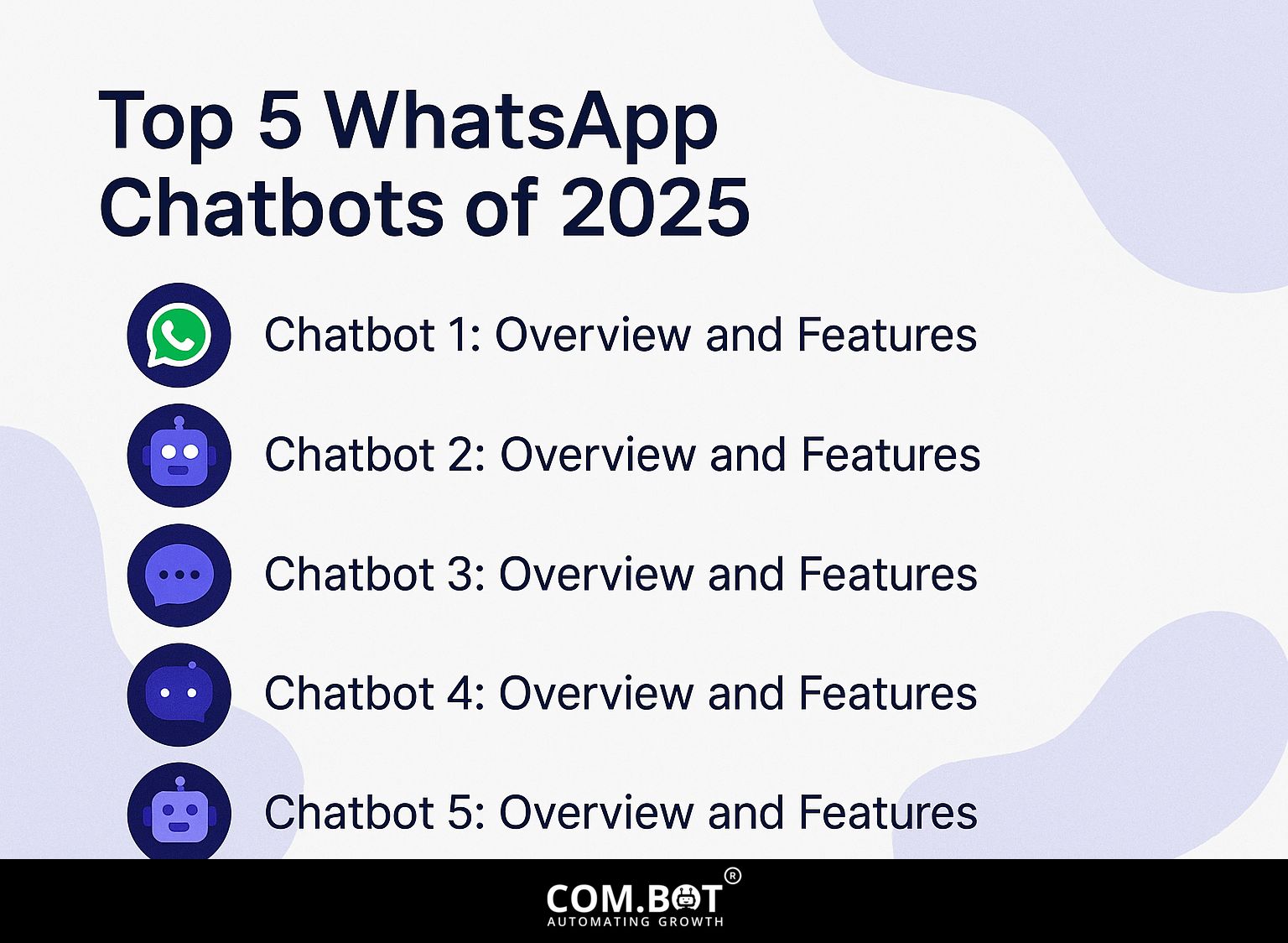
In 2025, the options for WhatsApp chatbots are changing quickly, with many tools available to meet different business requirements.
Chatbot 1: Overview and Features
Manychat is a top WhatsApp chatbot with strong features like flow builders, templates, and connections to eCommerce platforms.
With pricing ranging from free to $15 per month, Manychat allows users to scale their utilization based on needs.
Key features include:
- Keyword automation for seamless user interaction
- A drag-and-drop flow builder for easy customization
- Analytics to track engagement
Companies can connect it to platforms such as Shopify and WooCommerce to make selling easier.
Though Manychat is easy to use and flexible, some downsides are that the free version has limits on automatic sequences and there is a bigger learning curve for more advanced options.
Chatbot 2: Overview and Features
Chatbase is a strong WhatsApp chatbot that focuses on analytics and user engagement to improve customer interactions.
It provides strong analytics tools that monitor how users act and respond, aiding businesses in finding areas that need improvement. For instance, you can analyze conversation flow metrics to see where users drop off, enabling targeted adjustments.
Chatbase integrates seamlessly with popular platforms like Shopify and HubSpot, enhancing its utility. Pricing starts at $50 per month, which includes access to these analytics features and customer response tracking.
This setup helps companies improve their chat features quickly, leading to higher customer satisfaction and loyalty.
Chatbot 3: Overview and Features
UChat provides a multi-channel approach, allowing businesses to engage users across WhatsApp, Facebook, and other messaging platforms seamlessly.
UChat offers plans starting at $29/month, allowing customized interaction using automatic replies and chatbots that address user questions.
Businesses can use features such as broadcast messaging to contact customers at the same time or connect CRM tools for individualized follow-ups.
UChat’s analytics tools let you follow conversation metrics, helping you improve how you interact with others over time.
For example, a retail company might set up automatic replies for common questions and send specific messages to advertise holiday sales. This helps keep people interested without adding much extra work.
Chatbot 4: Overview and Features
Botpress offers an open-source tool that lets companies fully customize their WhatsApp chatbots, aimed at users with technical knowledge.
With Botpress, users can easily tailor chatbots using its intuitive flow-builder, which allows for drag-and-drop interface design. The platform easily links with various tools, such as NLP applications and databases, which makes it suitable for businesses with specific requirements.
Botpress follows a freemium model, providing a powerful foundation for free while offering advanced features and support through paid plans. This setup is especially beneficial for developers and startups wanting to use machine learning without large initial expenses, allowing for quick testing of ideas and implementation.
Chatbot 5: Overview and Features
Wati is designed specifically for eCommerce businesses, featuring customer support automation and easy integration with shopping platforms.
One of Wati’s standout features is its seamless integration with platforms like Shopify and WooCommerce, allowing businesses to manage customer inquiries directly through WhatsApp. Faster response times help make customers happier.
Prices begin at $49 per month, offering a practical option for small to medium-sized businesses. Wati helps with automatic replies to frequent questions, lowering the tasks for customer service teams.
This feature can greatly simplify operations, so staff can concentrate on more complicated tasks, improving overall productivity.
Applications Across Industries
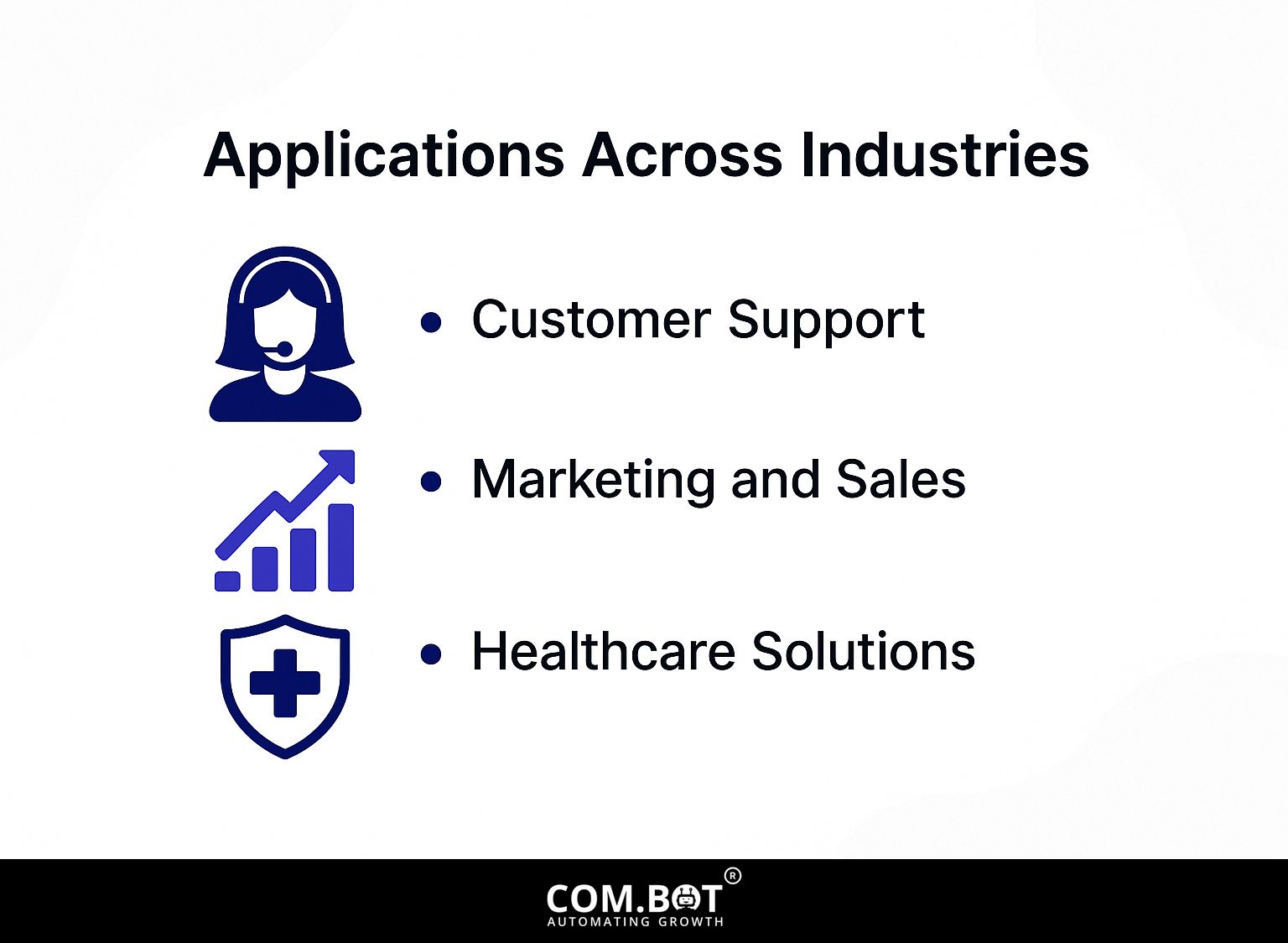
WhatsApp chatbots are useful tools used in different fields, such as customer service and healthcare, to improve productivity and interaction. If interested in exploring how these chatbots are transforming healthcare specifically, our detailed overview of WhatsApp Chatbots for Healthcare provides valuable applications and case studies.
1. Customer Support
WhatsApp chatbots in customer support automatically reply to typical questions, allowing human agents to concentrate on more difficult problems.
Tools like Chatfuel and ManyChat make it easier for businesses to set up custom chat interactions without needing any programming skills.
For example, a retail company might use Chatfuel to automatically respond to inquiries about product availability or shipment tracking, often providing responses in under a minute. This efficiency makes customers happier and decreases the work for support staff. Linking these chatbots with CRM systems records each customer interaction, improving the support experience.
2. Marketing and Sales
WhatsApp chatbots greatly improve marketing and sales by automatically gathering leads and customizing customer communication. By using automatic workflows, businesses can make it easier to collect and develop leads.
For example, using tools like ManyChat or Chatfuel, you can create a flow that engages users when they message your WhatsApp bot. Begin with a greeting, then ask users to share their email to get a discount.
After getting a lead, use a method to send follow-up messages with unique content or product recommendations that match their likes. This makes their experience feel more individual and raises the likelihood of turning them into customers.
3. Healthcare Solutions
In healthcare, WhatsApp chatbots offer patient support, appointment scheduling, and symptom checking, improving access to essential services.
These chatbots make tasks simpler. For instance, patients can quickly book appointments without waiting on the phone.
A successful implementation by the NHS allows patients to reschedule their appointments directly through the chat interface, reducing cancellation rates by 30%.
Chatbots can answer common patient inquiries, such as medication instructions, through natural language processing, enhancing the patient experience. As mentioned, WhatsApp Chatbots for Healthcare provides insightful applications and case studies that further illustrate these benefits.
Adding these features helps healthcare facilities run more smoothly and greatly increase patient satisfaction and involvement.
Frequently Asked Questions
1. What are the top 5 WhatsApp chatbots expected in 2025?
The five leading WhatsApp chatbots anticipated in 2025 include those driven by artificial intelligence, those focusing on customer support, virtual assistants, online shopping, and healthcare.
2. What are the key features of these WhatsApp chatbots?
Key features of these WhatsApp chatbots include using computer systems to process language, learning from data, customized replies, support for different languages, and integration with other apps and services.
3. How can businesses use these chatbots to their advantage?
Businesses can use these chatbots to handle customer service, answer questions quickly, operate smoothly, and give customers a simple and custom experience.
4. What are the potential applications of WhatsApp chatbots in 2025?
Some potential applications of WhatsApp chatbots in 2025 include sales and marketing, customer support, appointment scheduling, ordering and delivery, and healthcare services.
5. Will these chatbots replace human interaction on WhatsApp?
These chatbots are made to work with people and help them. They cannot match the emotional awareness and empathy found in human interaction.
6. What should users and businesses keep in mind when using WhatsApp chatbots?
Users and businesses should keep in mind the limitations of chatbots, such as handling complex queries and emotions. They should make sure the chatbot gets regular updates and training to give correct and useful answers.
